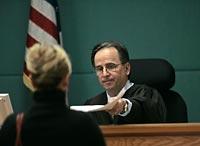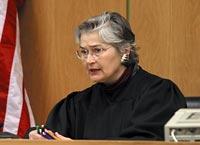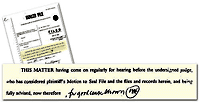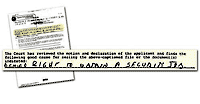|
Wednesday, April 14, 2010 - Page updated at 01:24 PM The cases your judges are hiding from youSeattle Times staff reporters This story was originally published March 5, 2006. Four years ago, a lawsuit was filed in King County Superior Court, alleging that a medical device was unsafe. A woman using it wound up in a coma. You'd probably like to know: What's the device? Does anyone in my family use it? Unsafe how? But you can't know. You're not allowed to know. Medtronic, the multibillion-dollar company that makes the device, asked a judge to conceal the whole file from public view — and the judge said OK. Twelve years ago, an Eastside family sued KinderCare, one of the country's largest child-care companies, saying it was responsible for the sexual abuse of a child. You'd like to know: Who was accused of sexual abuse? How was KinderCare involved? Were police notified? But you can't know. That file, too, is sealed — hidden away by a court commissioner who has sealed dozens of cases, stamping his name on one secrecy order after another. Document after document, file after file, has been sealed — and sealed improperly — by the judges and court commissioners of King County Superior Court. A wrongful-death lawsuit against Virginia Mason Medical Center? Sealed. A lawsuit accusing a King County judge of legal malpractice? Sealed. A lawsuit blaming the state's social-services agency for the rape of a 13-year-old girl? Sealed. Since 1990, at least 420 civil suits have been sealed in their entirety, The Seattle Times found. That means everything — from the complaint, which says who's accused of what, to the judgment, which says how the case wound up — has been concealed, locked behind electronic passwords or number-coded keypads that restrict access to computer records and shelved files. These sealed records hold secrets of potential dangers in our medicine cabinets and refrigerators; of molesters in our day-care centers, schools and churches; of unethical lawyers, negligent doctors, dangerous dentists; of missteps by local and state agencies; of misconduct by publicly traded companies into which people sink their savings. The Washington Constitution says: "Justice in all cases shall be administered openly." To this, many King County judges have effectively added: "unless the parties don't want it to be." The judges have displayed an ignorance of, or indifference to, the legal requirements for sealing court records. They have routinely sealed files while 1) offering little or no explanation, 2) applying the wrong legal standard, and 3) failing to acknowledge, much less weigh, the public interest in open court proceedings. At least 97 percent of their sealing orders disregard rules set down by the Washington Supreme Court in the 1980s. The state's highest court says court records should be sealed only in rare circumstances. Its message is: Your taxes pay for the courts. You're entitled to know what goes on there. You elect the judges. You need to know how they do their job. The public cannot evaluate its court system — nor hold judges accountable — if the courthouse curtains are drawn. Judges and commissioners have sealed at least 46 cases where a public institution is a party. Is some public agency slipping up? Some public employee? Are taxpayer dollars at risk? Good questions all, but you can't have the answers. Local school districts, the University of Washington, the state Department of Social and Health Services — all have had files sealed. Judges and commissioners have sealed at least 58 cases where a fellow lawyer is a party, usually as a defendant. Leading firms, prominent lawyers, judges — all have had files about them sealed. The courts have sealed cases where the person being sued was a licensed professional — for example, a doctor, psychologist or counselor — who was subsequently disciplined by the state. Those lawsuits might have served as a warning, had they not been concealed from the public. And the courts have sealed one case after another at the request of the rich and influential, including leaders in real estate, advertising, banking, medicine, software development, the Internet, general business and sports. The 420 cases that we found represent but a sliver of all the sealed records in our courthouses. That number applies only to civil suits in one court: King County Superior. We excluded other types of cases, such as divorce, adoption, paternity or child-custody matters. The 420 also accounts only for cases sealed in their entirety. Many others are sealed in part. We stopped counting those at 1,000. Two years ago, the Washington Supreme Court wrote: "The open operation of our courts is of utmost public importance. Justice must be conducted openly to foster the public's understanding and trust in our judicial system and to give judges the check of public scrutiny. Secrecy fosters mistrust." The court wrote that while unanimously reversing a King County judge who had improperly sealed court records in a business lawsuit. And this was a case where the judge sealed part of the file, not the whole thing. The same judge, Sharon Armstrong, has sealed the entire file in at least 11 cases since 1990. A lawsuit involving a pedophile priest? Sealed. A lawsuit against Metro for hitting a pedestrian in a crosswalk? Sealed. She has also sealed two lawsuits against the state Department of Social and Health Services, and three against lawyers or law firms. In months to come, The Seattle Times plans to get files unsealed and questions answered. The court's leadership crafted a plan that would have opened files with minimal delay, but other judges rebelled, saying the newspaper should be required to file a formal motion in each case that was improperly sealed. We're going to be filing lots of motions. Hiding harm When something goes wrong — a product fails, a doctor is negligent, a company cheats its customers or investors — lawsuits often follow, generating court files crammed with evidence accumulated by each side. But by sealing records, judges can conceal that evidence. Many also sign sweeping protective orders that allow the parties to dictate which records the public can see. Many permit the parties to settle secretly, even in cases involving public hazards. Examples abound nationally of dangers hidden by such steps. Tire treads that separate. Car fuel tanks that explode. Priests who molest children. Heart valves, painkillers and birth-control devices linked to dozens or even hundreds of deaths. Litigation has become a system of secrecy. A defendant, accused of wrongdoing, wants records produced during a lawsuit to stay between the parties. The plaintiff goes along to pave the way for settlement. The judge signs off because it's the easy thing to do. When the case is settled, the parties sign a confidentiality agreement. You ask the plaintiff about the lawsuit, and he says he can't talk. One result is that patterns — with products and with people — can get obscured. Take the case of LaVar Riniker, a Bellevue dentist with an unusual practice. He treated some patients' backaches or hip problems by changing the shape of their jaws, state records show. In 1996, Riniker's lawyer wanted a malpractice lawsuit against his client sealed. The plaintiff joined in, and a judge signed off. Two months later, the lawyer wanted a second lawsuit against Riniker sealed. The plaintiff went along, and so did a court commissioner. In 1998, the lawyer showed up again — with secrecy request No. 3. But this time, a judge said no. Judge LeRoy McCullough knew the law and said sealing the whole file would be improper. He did, however, allow the settlement terms to remain confidential. In 2000, the state refused to renew Riniker's dental license, finding he was incompetent. By then, Riniker had been sued for malpractice at least 16 times, court records show. Most of those lawsuits involved some level of secrecy — either the whole file was sealed, or the case was resolved confidentially. Riniker was, of course, an individual dentist. You probably never went to him. But other sealed lawsuits have alleged malpractice at such medical institutions as Group Health, Swedish, Virginia Mason and Harborview. Lazy sealing practices have allowed some people to play the courts for a fool. Michael Cassini, a convicted con man, scammed more than $4 million from banks by pretending to be a Microsoft millionaire. One way he covered his tracks was by changing his name — and, with the help of Preston Gates & Ellis, a prestigious law firm, getting a King County judge to seal the court file. Seth Warshavsky became rich in the 1990s selling pornography on the Internet. He was profiled extensively — the "Bill Gates of Porn," some stories called him — but proved an elusive figure. That's because the courts kept allowing him to erase his history. According to King County court records and newspaper reports, Warshavsky managed to seal: one civil suit in which he was accused of overbilling thousands of customer credit cards; a second civil suit accusing him of choking his former girlfriend; and criminal files in adult and juvenile court listing such priors as theft and trying to sell a stolen laptop. Warshavsky couldn't be reached for comment. Some reports say he fled to Thailand several years ago. Secrecy triumphs In lawsuits filed in King County, the parties' desire for secrecy has regularly trumped the public good. Consider case No. 95-2-22817-8. Because a judge sealed the file, all you're supposed to know about this case is the names of the parties and that it involves a tort — a wrongful act that you can sue somebody for. But someone made a mistake and left this file open. Every document popped up on the courthouse computer. (The file was closed two weeks ago, after we notified the clerk's office.) The documents told this story: In 1995, a young man sued Donald Sidwell, an aerospace worker with "top secret" security clearance whose job was so sensitive that he couldn't divulge what projects he worked on. The plaintiff accused Sidwell of sexually abusing him when the plaintiff was a child. (The Seattle Times does not name alleged victims of sexual abuse.) Sidwell denied the allegations. His attorney called them "totally false" and likened them to an extortion attempt. Still, Sidwell agreed to settle. On Jan. 30, 1997, the parties filed a document saying Sidwell would pay the young man $212,000. The same day, Sidwell's lawyers asked Superior Court Judge Harriett Cody to seal the whole file. Here's the reason they offered: Sidwell worked in the "high-security aerospace defense industry." His employer was Lockheed Martin, in Southern California. (He previously worked for Boeing in Washington state, which is where the alleged abuse occurred.) His "top secret" security clearance was granted to fewer than one in 20 employees. Sidwell's work made him subject to close surveillance and record-checking. Discovery of this lawsuit could mean loss of his security clearance and job. Without his job, he couldn't pay the young man. So, out of concern "for the plaintiff's recovery and the defendant's livelihood," the file should be sealed, Sidwell's lawyers wrote. Judge Cody sealed the file. The sealing request and the judge's order make no mention of Lockheed's interest in knowing what Sidwell was accused of. Nor do they mention the interest of the federal government, which issues security clearances — and has the power to take them away. Nor do they mention the potential for blackmail created here. What would happen if the wrong people learned of Sidwell's secret? Sidwell kept his job. The "defendant's livelihood" was protected. Now 67, Sidwell retired about a year and a half ago. But as for the "plaintiff's recovery"? That didn't work out so well. Nine years after the case was settled and the file sealed, Sidwell has paid only a fraction of the $212,000, according to the young man's lawyer. Sidwell told The Times that he still owes about $160,000 — and hopes to pay that off by selling some land. He still denies the sexual abuse. He settled, he said, because his attorney fees were getting too steep. And he's convinced that if Lockheed had learned of the lawsuit and settlement, he would have been fired. (Lockheed declined comment for this story.) So, in the end, the only person that secrecy served was Sidwell — the man who was accused of molesting a child, the man who agreed to pay $212,000 but hasn't. Unlawful orders The Washington Supreme Court says that to seal a file, a judge must: 1) find "compelling circumstances," a demanding legal standard; 2) explain, in an order, why secrecy is needed; and 3) weigh the arguments for privacy against the public's interest in open courts. We were able to get the sealing orders in 383 of the 420 sealed cases. Here's what they show: • In 361, or 94 percent, the court failed to find "compelling circumstances." The order used the wrong legal standard — citing "good cause," a much lower threshold — or used no standard at all. The difference between "good cause" and "compelling circumstances" is the difference between having some reason for secrecy — for example, the defendant doesn't want to be annoyed — and having a superior reason, one so persuasive it outweighs the constitutional presumption of openness. In Example 1, a judge sealed a file involving a priest accused of molesting children, writing in, by hand, that "good cause" was shown. • In 196 cases, or 51 percent, the sealing order offered no explanation for secrecy, much less a detailed one. And we were being generous here, counting such throwaway lines as "nature of allegations" as some explanation. In Example 2, a court commissioner used a fill-in-the-blank form to seal a medical-malpractice lawsuit. The top line is reserved for the court's explanation. She left that line blank. Note how this form uses the wrong standard — good cause — and leaves little room for explanation. The court is supposed to describe, in detail, the arguments for secrecy and weigh them against the Washington Constitution — but you couldn't even fit this sentence into that space. More than 100 cases have been sealed with this form. Nineteen times, the explanation line was left blank. • In 373 of the orders, or 97 percent, the judges not only failed to weigh the public interest — they didn't even acknowledge there is such an interest. This disregard can border on the absurd. In 1998, a King County man asked to have three lawsuits sealed. Two accused him of domestic violence, the other of harassment. A different woman filed each one. Here's why he wanted secrecy: The man wanted to be a security guard — a job that can require background checks — and said these lawsuits were in his way. A commissioner sealed all three. As you can see, in Example 3, the sealing orders did not take into account the obvious public interest in letting licensing officials and prospective employers view these court files. Without question, some records can meet these sealing requirements: bank-account numbers; personal information about children; psychiatric records; legitimate trade secrets. But the state Supreme Court has told judges to seal only those documents that need sealing — or, better yet, redact account numbers or use initials for minors. About half of these 383 cases were sealed by court commissioners, not judges. Commissioners have many of the same powers as judges but are not elected. Commissioners sealed files mostly while in a cattle-call court called the Ex Parte Department, where orders get signed with dizzying speed. King County judges tend to explain widespread sealing this way: The parties agreed to it — and judges like it when the parties agree. Judges sometimes view their role narrowly: to settle disputes, not start them; to handle issues raised by the parties, not to bring ones up. Michael Trickey, who became presiding judge of King County Superior Court in January, said: "I think the culture, among the bar and even the bench, used to be that if an agreed order was presented, it was just signed." Judges' roadblock Judge Trickey uses the past tense when he describes such relaxed sealing practices. He says judges have become more attuned to the public's right to open records. After we showed the judges our findings, they began to fix some problems. The court is throwing out its old sealing forms, providing extensive training to judges and commissioners on sealing restrictions, and taking the power to seal away from substitute commissioners. Late last year, when we alerted the court's leadership to the hundreds of improperly sealed files, a small group of top judges came up with a plan that would have opened many, if not most, with minimal delay. These judges included Trickey; Richard Eadie, the presiding judge from 2002 until this January; and William Downing, one of the state's leading experts on open court records. Under their plan, the court would have notified parties that files appeared to have been sealed improperly, and that the court would be opening them unless the parties voiced objection. But other judges on the court objected. In January they overturned the plan, by a vote of 21-9. Instead, the court is requiring The Seattle Times to file a motion in every case. Feel free to file 400 motions, the court has said, a demand that imposes extraordinary expense and delay. The judges who voted against the leadership's plan cited General Rule 15, a rule adopted by the Washington Supreme Court in 1989. The rule says that once sealed, records shall be unsealed only upon agreement of the parties, or upon motion and "proof of compelling circumstances." But this is the same rule that says a file should be sealed only for compelling circumstances. So: The judges ignored General Rule 15 while sealing hundreds of these cases. Now, they are requiring us to follow that rule to undo something that should not have been done in the first place. And, if they follow the rule to its letter, they will require the newspaper to show compelling circumstances to unseal, while they sealed on far less. That would flip the presumption of open courts on its head. Not every judge is going along. Judges are elected individually and can handle their cases as they choose. Dean Lum, the court's chief civil judge, unsealed one lawsuit last month without requiring the newspaper to file a motion. Judge Eadie unsealed another. "I see that the judge has an individual responsibility to step forward," Eadie says. "Not everybody agrees with that view." In 1999, Eadie sealed a medical-malpractice lawsuit. But he recently looked at his sealing order and said: "It doesn't give any description of why, or reflect any weighing of the public interest, or any indication of why the compelling circumstances outweigh the public interest." So Eadie sent a letter to the attorneys in January, saying: "This should not have been done. It was inconsistent with the rules in effect at the time and is in conflict with recent case law." His letter said he would open the file in a month. In the meantime, he wrote, the lawyers could ask that individual documents remain sealed, provided they could show compelling circumstances. The lawyers made no such request — and the whole file was opened. But hundreds of other files remain under seal. We start filing motions tomorrow. We'll let you know how it goes. Researcher David Turim contributed to this report. Ken Armstrong: 206-464-3730 or karmstrong@seattletimes.com; Justin Mayo: 206-464-3669 or jmayo@seattletimes.com; Steve Miletich: 206-464-3302 or smiletich@seattletimes.com. Copyright © 2007 The Seattle Times Company |
Seattle Times Special
Miracle Machines: The 21st-Century Snake Oil
The Favor Factory
Confronting Malaria
Pike Place Market
Your Courts, Their Secrets
License to Harm
The Bering Sea
Olympic Sculpture Park |


















